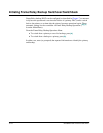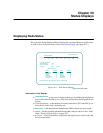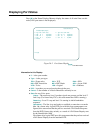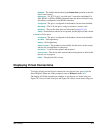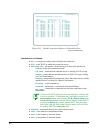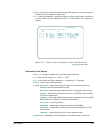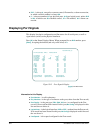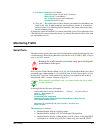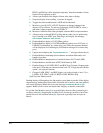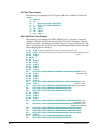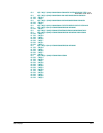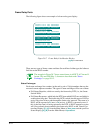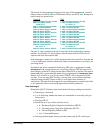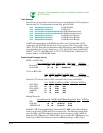
20-8 SmartSwitch 1800 4.0 User Guide, Rev 01
BECN, and DE bits will be displayed separately, then the remainder of each
frame will be displayed as data.
E
Allows specification of the length of frame relay data to display.
F
Stops the display from scrolling, or restarts if stopped.
H
Toggles the data format between ASCII and hexadecimal.
L
Monitors a specific LCN or DLCI. If packets are being exchanged, the
display will scroll them. To return to monitoring all LCNs/DLCIs, select
L
and enter
0
when prompted for an LCN/DLCI.
M
Monitors a different line; when prompted, enter the RLP and port numbers.
P
Allows tracing a selected SDLC polling address when you are performing
level-2 tracing of an SDLC port. Selecting
P
will display the message:
SDLC Station Address to filter (FF=All)
.
Q
Enables/disables display of X.25 QData packets.
R
Enables/disables display of X.25 Restart/Reset packets on an X.25 port, or
LMI DLCI information on a frame relay port. (Only the sequence numbers
will be displayed for Link Integrity Verification messages on a frame relay
port.)
S
Updates and redisplays the "
Display Selection is
:....." message (shown above).
T
Enables/disables timestamps (hours:minutes:seconds:milliseconds) and
lengths of packets.
W
Enables/disables interpretation of classified frames (LLC2 and LAPB).
Y
Enables/disables classification of RFC1490 frames by PID.
2
Enables display of all LAPB, SDLC, and BSC level-2 frames (if appropriate
to the port). (Note that you cannot monitor level-2 X.25 logical ports with this
option—use option
3
instead.)
3
Changes LAPB, SDLC, and BSC display (see
2
above) back to level 3 (i.e.,
LAPB to X.25, SDLC to QLLC, BSCI to DSP, BSCB to DQ).
[F3]
Exits Line Monitor mode.
Pending display of Data packets, the line monitor stores them in a buffer. If the display
cannot keep up with the line's data traffic, the buffer will overflow, and some packets
will not be displayed. When this occurs, the message
Line Monitor Buffer is Full
appears. Buffer overflow does not impair data integrity or interfere with traffic.
To exit the Line Monitor, press
[F]
to stop the display from scrolling (assuming it is
scrolling), then
[F3]
. (Stopping the scrolling first is not always necessary, but allows
quicker access to the software when
[F3]
is pressed, especially from an async ter-
minal.)



